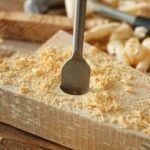What does EMC stand for in woodwork? EMC stands for “equilibrium moisture content,” and it is a crucial factor in the world of woodwork. Understanding and managing EMC is essential for ensuring the quality and longevity of wood products.
EMC refers to the moisture content at which wood reaches equilibrium with its surrounding environment. It plays a significant role in determining the stability, strength, and performance of wood in various applications. In this article, we will explore the basics of EMC in woodwork, its importance, the science behind it, testing and measurement methods, misconceptions, standards and regulations, as well as practical applications.
Importantly, maintaining the right EMC levels is vital for preventing problems such as warping, cracking, or shrinking in wood products. By gaining a solid understanding of EMC and its impact on wood properties, woodworking professionals can ensure superior results in their projects. So let’s delve into this important aspect of woodworking and unravel its significance and practical implications.
Importance of EMC in Woodwork
EMC, or Equilibrium Moisture Content, is a crucial factor in the world of woodwork. Understanding the importance of EMC in woodwork is essential for ensuring the quality and durability of wood products. This section will delve deeper into why EMC matters and its impact on woodworking projects.
Preservation of Wood
One of the key reasons why EMC matters in woodwork is its role in preserving the quality of wood. When wood has a higher moisture content than its equilibrium point, it can lead to warping, cracking, and decay. On the other hand, if the moisture content is too low, it can result in shrinkage and deformation. By understanding and controlling the EMC of wood, woodworkers can ensure that their products maintain their integrity and last longer.
Impact on Woodworking Processes
The EMC of wood also plays a significant role in woodworking processes such as milling, joinery, and finishing. Wood with a high moisture content can be more challenging to work with as it may be prone to tear-out during machining or have difficulty holding glue during assembly. Additionally, finishing processes such as painting or staining may be affected by fluctuations in moisture content. By considering EMC throughout the woodworking process, artisans can achieve better results and minimize waste.
Quality Assurance and Customer Satisfaction
Understanding the importance of EMC in woodwork is also essential for ensuring quality control and customer satisfaction. By adhering to specific EMC standards and regulations, manufacturers can guarantee that their products are consistent and meet industry requirements. This not only leads to higher customer satisfaction but also reduces issues related to product performance or returns due to poor quality resulting from improper management of moisture content in wood.
The Science Behind EMC in Woodwork
Understanding EMC in Woodwork
EMC stands for Equilibrium Moisture Content, and it refers to the moisture content at which wood is at equilibrium with its surrounding environment. In other words, it is the point at which the wood neither gains nor loses moisture when exposed to a specific relative humidity and temperature. Understanding EMC is crucial in woodwork as it directly affects the dimensional stability of wood products.
Factors Affecting EMC
Several factors influence the EMC of wood, including species, density, grain orientation, and temperature. Different types of wood have varying porosity and can absorb and release moisture differently. The density of the wood also plays a role in how much moisture it can hold. Additionally, the grain orientation affects how readily moisture can move through the wood. Lastly, temperature can impact the equilibrium moisture content as higher temperatures tend to decrease EMC.
Effects of EMC on Wood Products
The concept of EMC is essential in understanding how different wood products will behave in various environmental conditions. For example, an awareness of a specific type of wood’s EMC allows woodworkers to anticipate changes in dimensions due to fluctuations in humidity levels.
This knowledge enables them to make more accurate cuts and joints that will not be compromised by future changes in moisture content. Understanding EMC also helps prevent issues like warping, buckling, cracking, or shrinking of wood products after they have been manufactured.
By understanding the science behind Equilibrium Moisture Content (EMC) in woodworking, craftsmen can create long-lasting and durable wooden pieces that are less likely to be affected by changes in environmental conditions. It’s clear that mastering this concept is critical for any professional or hobbyist working with wood.
EMC Testing and Measurement in Woodwork
In the world of woodwork, EMC stands for equilibrium moisture content. It refers to the moisture level at which wood is stable and will not change its dimensions in response to changes in relative humidity or temperature. This is a crucial concept in woodworking as it directly affects the quality and durability of wooden products.
EMC testing and measurement play a vital role in ensuring quality control in woodwork. By accurately determining the equilibrium moisture content of wood, woodworkers can anticipate and minimize problems such as warping, cracking, or splitting that may occur after the product has been manufactured. This is especially important for items such as furniture, cabinetry, and flooring where stability is essential.
To conduct EMC testing and measurement, various methods are used including oven-drying and electronic moisture meters. These tools help determine the amount of moisture present in the wood, allowing woodworkers to make informed decisions about how to properly prepare and handle the material during production. By regularly monitoring EMC throughout the manufacturing process, woodworkers can ensure that their products meet industry standards for stability and performance.
Overall, EMC testing and measurement are critical components of quality control in woodwork. By understanding and carefully managing the equilibrium moisture content of wood, woodworkers can produce high-quality products that are less prone to issues related to dimensional instability. This ultimately leads to greater customer satisfaction and confidence in the durability of wooden goods.
Common Misconceptions About EMC in Woodwork
Many people in the woodworking industry have misconceptions about EMC, or equilibrium moisture content, and its impact on woodwork. It is important to debunk these myths in order to have a better understanding of how EMC truly affects woodwork.
One common misconception about EMC in woodwork is that it only affects the appearance of the wood. In reality, EMC plays a crucial role in determining the dimensional stability and structural integrity of wood products. When wood undergoes changes in moisture content, it can lead to warping, cracking, or shrinking, which can compromise the quality of the final product.
Another myth surrounding EMC in woodwork is that it only matters for outdoor or high-moisture applications. However, even indoor furniture and carpentry are susceptible to changes in moisture content. Understanding and controlling EMC is essential for ensuring that wood products maintain their shape and durability over time, regardless of their environment.
It is also a common misconception that all types of wood will reach the same EMC. Different species of wood have different properties and will reach different equilibrium moisture content levels depending on their specific characteristics. This underscores the importance of understanding the unique behavior of each type of wood when working with it.
EMC Standards and Regulations in Woodwork
In the realm of woodworking, EMC stands for “Equilibrium Moisture Content.” This refers to the point at which wood has reached a balance between its moisture content and the relative humidity of the surrounding environment. Understanding and adhering to EMC standards and regulations is crucial in ensuring that wood products meet quality control measures and are fit for their intended use.
Compliance with EMC standards is essential because it directly impacts the performance, durability, and stability of wood products. When wood is not properly dried or acclimated to its environment, it can lead to problems such as warping, twisting, splitting, or even mold growth. To prevent these issues, regulatory bodies have established guidelines for EMC levels based on the specific type of wood, its intended use, and the geographical location where it will be utilized.
Certification processes for EMC compliance typically involve testing wood samples to measure their equilibrium moisture content. These tests may be conducted using specialized equipment such as moisture meters or environmental chambers to simulate different humidity conditions. By comparing the results against established standards, manufacturers can ensure that their wood products align with regulatory requirements.
Adhering to EMC standards and regulations not only ensures product quality but also promotes safety and customer satisfaction. By obtaining certification for EMC compliance, woodworking businesses can demonstrate their commitment to producing reliable and long-lasting wood products. Additionally, adherence to these standards helps protect consumers from potential hazards associated with improperly dried or acclimated wood materials. Thus, compliance with EMC regulations is fundamental for maintaining industry credibility and upholding the integrity of woodworking practices.
| Importance of EMC Compliance | Certification Process |
|---|---|
| Ensures product quality | Involves testing wood samples |
| Promotes safety | Comparing results against standards |
| Demonstrates commitment to reliability | Protects consumers from hazards |
Practical Applications of EMC in Woodwork
Woodworkers and manufacturers understand the importance of EMC in woodwork, as it directly impacts the quality and performance of wood products. One practical application of EMC in woodwork is the control of moisture content in wood. By understanding and monitoring EMC, woodworkers can ensure that the moisture content of the wood is at an optimal level for specific applications, such as furniture making or construction.
Another real-life example of the practical application of EMC in woodwork is in the manufacturing of wooden musical instruments. For instance, guitars and violins require specific moisture levels to produce optimal sound quality and prevent warping or cracking. By carefully controlling EMC during the production process, instrument makers can achieve consistent results and high-quality products.
Furthermore, understanding EMC in woodwork allows for improved efficiency in woodworking processes. For example, by knowing how moisture content affects the dimensions and stability of wood, manufacturers can reduce material waste and improve yield. This not only leads to cost savings but also promotes sustainability by minimizing resource use.
Conclusion
In conclusion, understanding and implementing EMC in woodwork is crucial for achieving superior results. As explained throughout this article, EMC stands for equilibrium moisture content, which refers to the moisture level at which wood can maintain under specific environmental conditions. It is essential to consider EMC in woodwork as it significantly influences the performance and quality of wood products.
By recognizing the importance of EMC in woodwork, professionals can ensure that the wood they use is suitable for its intended purpose and environment. This understanding allows for better decision-making when selecting, storing, and working with wood. Furthermore, complying with EMC standards and regulations is necessary for ensuring quality control and certification in the woodworking industry.
Ultimately, embracing EMC in woodwork can lead to various benefits, including minimized warping, cracking, and degradation of wooden products. By testing and measuring EMC levels in wood, manufacturers can guarantee the longevity and durability of their creations. Therefore, it is imperative for woodworking professionals to familiarize themselves with EMC concepts and integrate them into their practices to achieve superior results.
Frequently Asked Questions
What Does EMC Stand for in Carpentry?
EMC in carpentry stands for “equilibrium moisture content.” This refers to the moisture content that wood reaches when it is neither gaining nor losing moisture from the surrounding environment.
What Is EMC in Timber?
In timber, EMC refers to the equilibrium moisture content of the wood. This is an important factor to consider when working with timber, as it can affect the stability and strength of the wood.
What Is the EMC in Kiln Drying?
The equilibrium moisture content (EMC) in kiln drying refers to the point at which the wood has reached a balance with its surrounding environment in terms of moisture content. Maintaining proper EMC during kiln drying is crucial for preventing issues such as warping or cracking in the wood.

Hi everyone! I’m a woodworker and blogger, and this is my woodworking blog. In my blog, I share tips and tricks for woodworkers of all skill levels, as well as project ideas that you can try yourself.





